
Core strengthening exercises after back surgery are more than just rehab routines — they fix one of the biggest reasons people struggle after surgery: a weak, unstable core. After back surgery, many people move less out of fear. Muscles shrink. Balance suffers. Even simple tasks like standing up or walking can feel risky. The spine ends up doing all the work alone — and that’s a problem.
Core training changes that. It gives your spine the support it needs. It helps you stay upright, move with control, and rebuild strength where it matters most. In this guide, you’ll learn which exercises are safe, effective, and worth your time during recovery.

After surgery, your spine is vulnerable. What happens next depends on one thing: your core. A strong core supports your spine. A weak core leaves it exposed.
Here’s the difference:
| With Strong Core | With Weak Core |
|---|---|
| Spine feels supported and stable | Spine feels shaky, every movement feels risky |
| Movements like walking or standing feel controlled | Simple tasks feel hard — or even painful |
| Posture stays upright and balanced | Slouching, stiffness, and uneven weight distribution |
| Pain is less likely to return | High risk of flare-ups and long-term discomfort |
| Confidence to move and get back to normal life | Fear of reinjury leads to more inactivity |
| Faster, more complete recovery | Healing stalls — recovery feels frustrating and slow |
👉 That’s the power of core training. It’s not just about strength — it’s about getting your life back.
Let’s look at the safest, most effective exercises to rebuild your core after surgery.

In the early weeks after surgery, your goal is to wake up the deep core muscles that help protect your spine. This stage is about slow, controlled movements you can safely do while lying down.
Abdominal Bracing
Ankle Pumps
Heel Slides
Tips for This Stage:

In this phase, the goal is to rebuild control and protect your spine. These exercises help your core stay active while your body moves. This is important for staying safe and building confidence after surgery.
Bird Dog
Glute Bridge
Marching in Bridge Position
Tips for This Stage:

This final stage of core strengthening exercises after back surgery helps you move with control and confidence. It prepares your body for walking, lifting, and everyday activity.
Stationary Bike (Low Resistance)
Standing Side Leg Raises
Abdominal Draw-In (Stomach Vacuum)
Tips for This Stage:
Recovery after back surgery isn’t just about rest — it’s about rebuilding the strength that protects your spine every day. That’s why core strengthening exercises after back surgery matter so much. They reduce pain and improve stability.
Start slow, stay consistent, and trust the process. The right core exercises — even simple tools like an ab core exerciser — do more than help you heal — they build lasting support for your whole body. Stick with the basics, and over time, you’ll notice real changes in how you move, feel, and go about your day.

I’m Max Lane, a dedicated fitness professional and the content strategist behind Inpek Fitness. With over ten years of hands-on experience in the fitness and gym equipment industry, I bring a practical and insightful perspective to every article I write. My background in strength training and commercial gym solutions allows me to dive deep into the mechanics and benefits of Pin Loaded Machines, Plate Loaded Machines, Multi Function Gym Machines, Gym Multi Stations, and Free Weights. Whether you’re managing a fitness facility or striving to improve your own performance, my goal is to deliver clear, actionable insights that help you succeed. Outside of writing, I’m passionate about weightlifting, staying active, and discovering new ways to push the boundaries of modern fitness.
Looking to enhance your gym with premium equipment? Have inquiries or ideas? Complete the form below to engage with our expert team. We’ll work with you to realize your fitness facility goals efficiently and effectively.